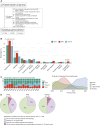Assessing Racial Disparities in Guideline-Concordant Care and Clinical Outcomes after Surgical Resection of Nonmetastatic Colon Cancer at a Comprehensive Cancer Center
- PMID: 40586283
- PMCID: PMC12272046
- DOI: 10.1158/2767-9764.CRC-24-0633
Assessing Racial Disparities in Guideline-Concordant Care and Clinical Outcomes after Surgical Resection of Nonmetastatic Colon Cancer at a Comprehensive Cancer Center
Abstract
In this study, we examined racial disparities in guideline-concordant care (GCC) and clinical outcomes of patients with colon cancer treated at a single comprehensive cancer center. We analyzed data from self-reported Hispanic, non-Hispanic Black (NHB), and non-Hispanic White (NHW) patients who underwent curative colectomy for stage I to III colon cancer between 2006 and 2021 at Memorial Sloan Kettering Cancer Center. GCC was defined as retrieval of ≥12 lymph nodes and appropriate receipt of adjuvant chemotherapy. Recurrence and overall survival from the time of surgery were compared using the Kaplan-Meier method and the log-rank test. Multivariable analyses were performed using Cox regression. The study included 2,209 patients, with 1,911 NHW, 153 NHB, and 145 Hispanic patients. NHW patients were older, whereas NHB patients had higher percentages of Medicaid coverage, obesity, and lower socioeconomic status. NHB patients more often presented with stage III disease and underwent open surgery. Receipt of GCC was not different by race. NHB patients had the highest 5-year recurrence rate compared with NHW and Hispanic patients (27% vs. 15.7% vs. 15.1%; P = 0.03). NHB race (HR = 1.43; P = 0.07) and low body mass index (HR = 1.98; P = 0.05) were associated with an increased risk of recurrence with marginal significance. NHB race was associated with an increased risk of recurrence in stage I disease (HR = 3.52; P = 0.03). NHB patients had shorter recurrence-free survival, despite standardized quality of care. NHB race was independently associated with an increased risk of recurrence in stage I disease.
Significance: This study compares receipt of GCC, disease recurrence, and survival among White, Black, and Hispanic patients with nonmetastatic colon cancer treated at a single comprehensive cancer center with standardized quality of care and comparable access to health care. Black patients had higher rates of recurrence in this study.
©2025 The Authors; Published by the American Association for Cancer Research.
Conflict of interest statement
J. Garcia-Aguilar reports personal fees from Intuitive Surgical outside the submitted work. F. Sanchez-Vega reports grants from Corning Incorporated and Colorectal Cancer Alliance during the conduct of the study. No disclosures were reported by the other authors.
Figures


Similar articles
-
Racial Disparities in Receipt of Guideline-Concordant Care in Older Adults With Early Breast Cancer.JAMA Netw Open. 2024 Oct 1;7(10):e2441056. doi: 10.1001/jamanetworkopen.2024.41056. JAMA Netw Open. 2024. PMID: 39446324 Free PMC article.
-
Trends in Guideline-Concordant Care for Inflammatory Breast Cancer.JAMA Netw Open. 2025 Feb 3;8(2):e2454506. doi: 10.1001/jamanetworkopen.2024.54506. JAMA Netw Open. 2025. PMID: 40009385 Free PMC article.
-
Racial and Ethnic Disparities in Receipt of ERBB2-Targeted Therapy for Breast Cancer, 2010-2020.JAMA Netw Open. 2025 May 1;8(5):e258086. doi: 10.1001/jamanetworkopen.2025.8086. JAMA Netw Open. 2025. PMID: 40310643 Free PMC article.
-
Impact of residual disease as a prognostic factor for survival in women with advanced epithelial ovarian cancer after primary surgery.Cochrane Database Syst Rev. 2022 Sep 26;9(9):CD015048. doi: 10.1002/14651858.CD015048.pub2. Cochrane Database Syst Rev. 2022. PMID: 36161421 Free PMC article.
-
Hysterectomy with radiotherapy or chemotherapy or both for women with locally advanced cervical cancer.Cochrane Database Syst Rev. 2015 Apr 7;(4):CD010260. doi: 10.1002/14651858.CD010260.pub2. Cochrane Database Syst Rev. 2015. Update in: Cochrane Database Syst Rev. 2022 Aug 22;8:CD010260. doi: 10.1002/14651858.CD010260.pub3. PMID: 25847525 Updated.
References
MeSH terms
Grants and funding
LinkOut - more resources
Full Text Sources
Medical

